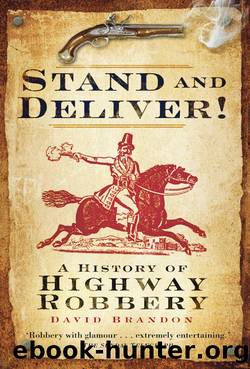Stand and Deliver! by David Brandon

Author:David Brandon
Language: eng
Format: epub
Tags: Stand and Deliver !
ISBN: 9780752468204
Publisher: The History Press
Published: 2011-09-08T00:00:00+00:00
9
ROAD TRAVEL IN GEORGIAN TIMES
By the beginning of the eighteenth century Britain had a road system but its inadequacies added enormously to the cost of transport and to the price of goods. These problems were retarding the countryâs industrial development at a time when the growth of commerce and the needs of public administration increased the demand for and amount of travel. The most effective way of travelling was on horseback and in favourable conditions distances of 30 to 70 miles could be covered in a day. Horse-drawn wagons carrying goods and passengers lumbered along at speeds rarely exceeding 3 miles an hour and pack trains of mules carrying all kinds of articles moved even more slowly. The poor condition of the roads is exemplified by Daniel Defoeâs description of an old woman being drawn to church near Lewes in Sussex by six oxen because horses would not have been able to move through the mire. Even around the capital the situation was no better. In 1736 an anonymous writer complained of the state of the road between Kensington and London, âIt is grown so infamously bad that we live here in the same solitude as we should do if cast on a rock in the middle of the ocean, and all the Londoners tell us that there is between them and us a great impassable gulf of mud.â
In 1706 Parliament sanctioned a new system which allowed a group of trustees to borrow money to finance road improvements along a specified section of road and to levy charges from road-users. These âTurnpike Trusteesâ fenced off the designated piece of road and erected toll-levying facilities at both ends and where any other roads joined along the way. The income from tolls was to be used to improve and maintain that particular section of highway. The turnpike idea took root and by the 1830s, the beginning of the railway age, England and Wales had about 1,100 turnpike trusts which between them administered 22,000 miles of main road. This was something like 20 per cent of the rural road mileage. The great drawback of the turnpikes was that the trusts were purely local bodies and no attempt was made to develop a national system of turnpiked highways. It meant that a long journey was likely to involve both turnpiked and ordinary road, the contrast between the two being very obvious. However, the turnpike system did enable road surfaces to be significantly improved and on a few major roads, such as those from London to Edinburgh, Manchester, Shrewsbury, Bristol and Portsmouth, virtually the whole route was turnpiked.
Daniel Defoe, writing in 1724, was impressed with the improvement of the Essex roads as a result of the building of turnpikes: âThe great road from London . . . towards Ipswich and Harwich, is the most worn with wagons, carts and carriages; and with infinite droves of black cattle, hogs and sheep of any road in England . . . These roads were formerly deeply rutted, in
Download
This site does not store any files on its server. We only index and link to content provided by other sites. Please contact the content providers to delete copyright contents if any and email us, we'll remove relevant links or contents immediately.
Machine Learning at Scale with H2O by Gregory Keys | David Whiting(4256)
Never by Ken Follett(3874)
Harry Potter and the Goblet Of Fire by J.K. Rowling(3802)
Unfinished: A Memoir by Priyanka Chopra Jonas(3353)
Fairy Tale by Stephen King(3302)
The Man Who Died Twice by Richard Osman(3035)
Will by Will Smith(2864)
Rationality by Steven Pinker(2321)
The Dark Hours by Michael Connelly(2278)
Can't Hurt Me: Master Your Mind and Defy the Odds - Clean Edition by David Goggins(2267)
It Starts With Us (It Ends with Us #2) by Colleen Hoover(2251)
The Storyteller by Dave Grohl(2197)
Friends, Lovers, and the Big Terrible Thing by Matthew Perry(2176)
The Dawn of Everything: A New History of Humanity by David Graeber & David Wengrow(2152)
The Becoming by Nora Roberts(2144)
The Stranger in the Lifeboat by Mitch Albom(2086)
Cloud Cuckoo Land by Anthony Doerr(2052)
Love on the Brain by Ali Hazelwood(2014)
Einstein: His Life and Universe by Walter Isaacson(1983)
